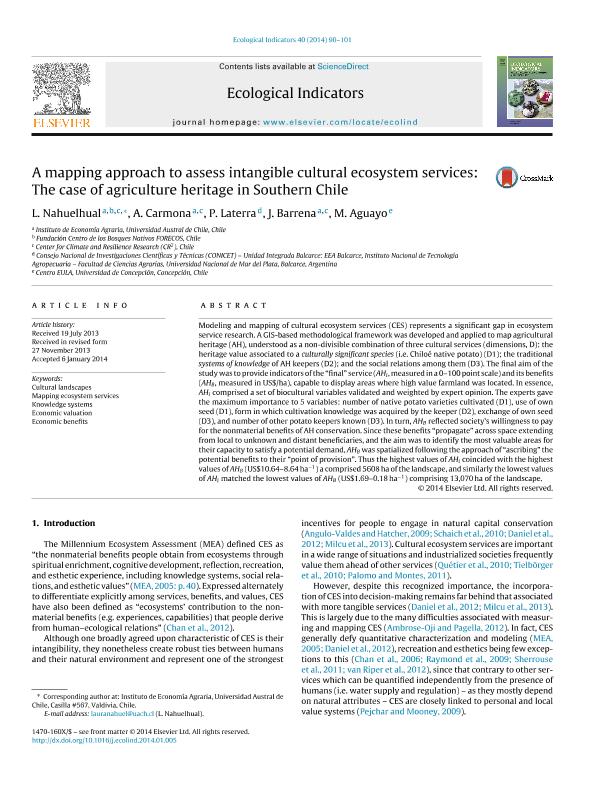Mostrar el registro sencillo del ítem
dc.contributor.author
Nahuelhual, Laura

dc.contributor.author
Carmona, A.
dc.contributor.author
Laterra, Pedro

dc.contributor.author
Barrena, José
dc.contributor.author
Aguayo, Mauricio
dc.date.available
2017-10-02T18:39:49Z
dc.date.issued
2014-01
dc.identifier.citation
Nahuelhual, Laura; Carmona, A.; Laterra, Pedro; Barrena, José; Aguayo, Mauricio; A mapping approach to assess intangible cultural ecosystem services: The case of agriculture heritage in Southern Chile; Elsevier Science; Ecological Indicators; 40; 1-2014; 90-101
dc.identifier.issn
1470-160X
dc.identifier.uri
http://hdl.handle.net/11336/25623
dc.description.abstract
Modeling and mapping of cultural ecosystem services (CES) represents a significant gap in ecosystem service research. A GIS-based methodological framework was developed and applied to map agricultural heritage (AH), understood as a non-divisible combination of three cultural services (dimensions, D): the heritage value associated to a culturally significant species (i.e. Chiloé native potato) (D1); the traditional systems of knowledge of AH keepers (D2); and the social relations among them (D3). The final aim of the study was to provide indicators of the “final” service (AHi, measured in a 0–100 point scale) and its benefits (AHB, measured in US$/ha), capable to display areas where high value farmland was located. In essence, AHi comprised a set of biocultural variables validated and weighted by expert opinion. The experts gave the maximum importance to 5 variables: number of native potato varieties cultivated (D1), use of own seed (D1), form in which cultivation knowledge was acquired by the keeper (D2), exchange of own seed (D3), and number of other potato keepers known (D3). In turn, AHB reflected society's willingness to pay for the nonmaterial benefits of AH conservation. Since these benefits “propagate” across space extending from local to unknown and distant beneficiaries, and the aim was to identify the most valuable areas for their capacity to satisfy a potential demand, AHB was spatialized following the approach of “ascribing” the potential benefits to their “point of provision”. Thus the highest values of AHi coincided with the highest values of AHB (US$10.64–8.64 ha−1) a comprised 5608 ha of the landscape, and similarly the lowest values of AHi matched the lowest values of AHB (US$1.69–0.18 ha−1) comprising 13,070 ha of the landscape.
dc.format
application/pdf
dc.language.iso
eng
dc.publisher
Elsevier Science

dc.rights
info:eu-repo/semantics/openAccess
dc.rights.uri
https://creativecommons.org/licenses/by-nc-nd/2.5/ar/
dc.subject
Cultural Landscapes
dc.subject
Mapping Ecosystem Services
dc.subject
Knowledge Systems
dc.subject
Economic Valuation
dc.subject
Economic Benefits
dc.title
A mapping approach to assess intangible cultural ecosystem services: The case of agriculture heritage in Southern Chile
dc.type
info:eu-repo/semantics/article
dc.type
info:ar-repo/semantics/artículo
dc.type
info:eu-repo/semantics/publishedVersion
dc.date.updated
2017-09-29T14:43:04Z
dc.journal.volume
40
dc.journal.pagination
90-101
dc.journal.pais
Países Bajos

dc.journal.ciudad
Amsterdam
dc.description.fil
Fil: Nahuelhual, Laura. Universidad Austral de Chile; Chile. Fundación Centro de los Bosques Nativos ; Chile. Center for Climate and Resilience Research; Chile
dc.description.fil
Fil: Carmona, A.. Universidad Austral de Chile; Chile. Center for Climate and Resilience Research; Chile
dc.description.fil
Fil: Laterra, Pedro. Consejo Nacional de Investigaciones Científicas y Técnicas; Argentina. Instituto Nacional de Tecnología Agropecuaria. Centro Regional Buenos Aires Sur. Estación Experimental Agropecuaria Balcarce; Argentina. Universidad Nacional de Mar del Plata. Facultad de Ciencias Agrarias; Argentina
dc.description.fil
Fil: Barrena, José. Universidad Austral de Chile; Chile. Center for Climate and Resilience Research; Chile
dc.description.fil
Fil: Aguayo, Mauricio. Universidad de Concepción; Chile
dc.journal.title
Ecological Indicators

dc.relation.alternativeid
info:eu-repo/semantics/altIdentifier/url/http://www.sciencedirect.com/science/article/pii/S1470160X14000077
dc.relation.alternativeid
info:eu-repo/semantics/altIdentifier/doi/http://dx.doi.org/10.1016/j.ecolind.2014.01.005
Archivos asociados
